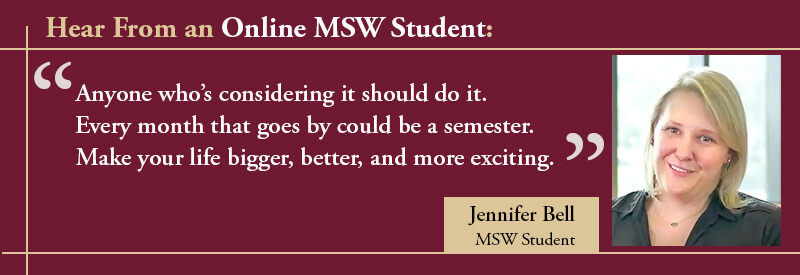Poverty and Social Work

Katie Krukenberg is an MSW graduate (2006) from Florida State University and a licensed clinical social worker in North Dakota. She works at the University of Mary and is an assistant professor of social work, as well as the director of field education for the social work program.
Poverty is an issue with no single cause. Addressing it is challenging due to the complexities that sustain it. Social workers have a responsibility to act on behalf of clients and tend to the broader needs of society- this includes tackling the immediate effects of poverty, as well as working to decrease it over time. Students in Florida State University’s online MSW program learn about the role of social workers in addressing poverty and ensuring social justice.
Prevalence
Definitions of poverty and eligibility criteria vary. The standard is typically based on the Federal Poverty Level (FPL) income guidelines- this is determined by the federal government each year. For instance, the most recent FPL threshold for a family of four is $25,750, meaning that families making this amount or less are considered to be living in poverty.
The U.S. Census Bureau reports data on income and poverty for each year in September of the following year, with 2017 data being the most recent information available. In 2017 the national poverty rate was 12.3 percent, representing the number of people whose income fell below the poverty level. Of this number:
- 6.7 percent of the population (21.3 million people) are in deep poverty, with incomes below 50 percent of their poverty thresholds based on family size.
- 29.8 percent of the population (95 million people) live near poverty, with incomes less than two times that of their poverty thresholds (Poverty USA, 2019).
Those living in poverty include higher rates of:
- Women
- Single parents, especially single mothers
- Children
- Elderly
- People with disabilities
- People of minority races including Native American, Black, and Hispanic
Impact
The impact of poverty is far-reaching, both for individuals and communities as a whole. On an individual level, poverty is more than just an income deficit, often affecting all parts of a person’s life. When the focus is on surviving, there is a lack of opportunity to thrive. People living in poverty may experience decreased:
- Education
- Nutrition
- Access to health care
- Community involvement
Over time, this can take a toll on a person’s physical and mental well-being, in addition to creating generational poverty.
On a macro level, poverty is often considered by critical theorists as being perpetuated by social isolation. This is defined as, “a complex process that involves the lack or denial of resources, and the inability to participate in the normal relationships and activities available to the majority of people in a society, whether in economic, social, cultural or political arenas.”.
Those most impacted by poverty encounter barriers, such as limited resources or high crime rates, which makes it difficult to participate in their communities. Without ongoing support, dynamics that sustain poverty may go unaddressed.
The Social Work Role
Social workers are essential in helping individuals and families, as well as communities at large. Here are four ways social workers prepare themselves to address poverty:
1. Education:
Learning about the mission of the social work profession, various roles that social workers hold, and strategies for tackling social justice issues are crucial in gaining the foundation needed to do impactful work. Higher education broadens the knowledge and professional capabilities of social workers in practice.
2. Meeting Basic Needs:
Maslow’s Hierarchy of Needs (Maslow, 1943) indicates that physiological needs such as food, clothing, shelter, and sleep are essential components to quality of life- these areas are constantly evaluated and tended to when working with clients. Social workers are well versed in resources within their communities, and knowledge regarding various assistance programs, eligibility requirements, and services to help fill delivery gaps are critical when assisting clients severely impacted by poverty. Helping ensure basic needs are consistently met creates a pathway for clients to stop living in survival mode and to begin planning for their future.
3. Awareness:
To stay informed of resources available and processes to access services, social workers must take steps to gain awareness about their community. This awareness should include community members, stakeholders, funding streams, and opportunities for collaboration. Joining coalitions formed around targeted issues can promote awareness of needs and services. They can also serve as a means for organizing public meetings or workshops, as well as awareness campaigns through news and social media.
4. Campaigning:
Social workers are knowledgeable about the clients and communities they serve. Because of this, social workers are powerful supporters on behalf of their clients and work to address barriers within the community. These efforts may increase access to services, as well as support the expansion of services available to those impacted by poverty. Social workers can also work at the state or federal level, voicing the need for policy changes.
Students in Florida State University’s online MSW program learn about the role of social workers in addressing poverty both individually and in communities to promote the highest quality of life for all.
Complete The Form to Access Your MSW Program Guide
For more information on ways that social workers help address poverty, please see our blog post 5 Ways that an Ecological Approach to Social Work Alleviates Economic Injustice.
References:
- Maslow, A. H. (1943). A theory of human motivation. Psychological Review, 50(4), 370-396.
- Federal Poverty Level (pl) - Healthcare.gov Glossary https://www.healthcare.gov/glossary/federal-poverty-level-fpl/
- The Population Of Poverty USA https://www.povertyusa.org/facts
